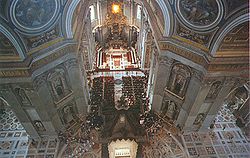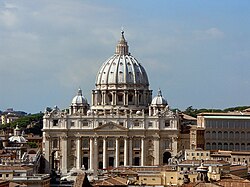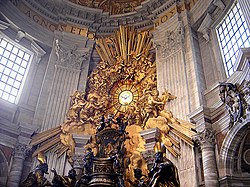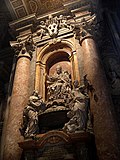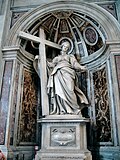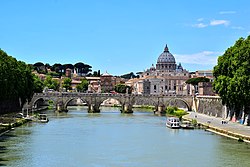St. Peter's Basilica
St. Peter's Basilica, which is called "Basilica di San Pietro in Vaticano" in Italian, is a large church in the Vatican City, in Rome, Italy. It is often called “the greatest church in Christendom".[2][3] In Catholic tradition, St. Peter's Basilica is believed to be the burial place of Saint Peter, who was one of the twelve apostles of Jesus. It is believed that Saint Peter was the first Bishop of Rome.
| St. Peter's Basilica | |
|---|---|
| Papal Basilica of St. Peter in the Vatican | |
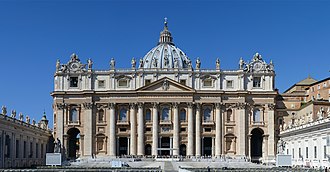 | |
| 41°54′08″N 12°27′12″E / 41.90222°N 12.45333°ECoordinates: 41°54′08″N 12°27′12″E / 41.90222°N 12.45333°E | |
| Location | Vatican City |
| Country | Holy See |
| Denomination | Roman Catholic |
| Tradition | Latin Rite |
| Website | St. Peter's Basilica |
| History | |
| Status | Papal major basilica |
| Dedication | Saint Peter |
| Consecrated | 18 November 1626 |
| Architecture | |
| Architect(s) | |
| Style | Renaissance and Baroque |
| Groundbreaking | 18 April 1506 |
| Completed | 18 November 1626 |
| Specifications | |
| Length | 220 metres (720 ft) |
| Width | 150 metres (490 ft) |
| Height | 136.6 metres (448 ft)[1] |
| Nave height | 46.2 metres (152 ft) |
| Dome diameter (outer) | 42 metres (138 ft) |
| Dome diameter (inner) | 41.51 metres (136.2 ft) |
| Administration | |
| Diocese | Rome |
| Clergy | |
| Archpriest | Angelo Comastri |
| Official name | Vatican City |
| Type | Cultural |
| Criteria | i, ii, iv, vi |
| Designated | 1984 (8th session) |
| Reference no. | 286 |
| State Party | Holy See |
| Region | Europe and North America |
Although the Bible does not say that the apostle Peter went to Rome, other Roman Christians who were alive in the 1st century AD have written about him.[4] Catholics believe that after Peter was killed, his body was buried in a cemetery where the basilica now stands. A tomb has been found below the altar of the basilica, and there were some bones, but no-one can say for certain if they are the bones of St. Peter.
A church was built here in the 4th century AD. The building that stands here now was begun on April 18, 1506 and was finished in 1626.[5] Many Popes have been buried there. Although many people think St. Peter's is a cathedral, it is not, because it does not have a bishop. The pope is the Bishop of Rome, and although he usually uses St. Peter's as his main church, because he lives in the Vatican, his bishop's throne is in a different church, the cathedral of Saint John Lateran. Large important churches like St. Peter's are often called basilicas. There are four ancient basilicas in Rome that were begun by the Emperor Constantine soon after he made Christianity the legal religion of the Roman Empire in the early 4th century AD (300s). The basilicas are St. Peter's Basilica, St. John Lateran, Santa Maria Maggiore and St. Paul outside the Walls.
St. Peter's is famous for many reasons:
- The pope, who lives at the Vatican, often says mass at St. Peter's.
- Many people go there on pilgrimage.
- It is said to be the greatest work of architecture of its age.[6]
- It has works by many famous artists including Michelangelo and Bernini.
- St. Peter's is probably the largest Christian church in the world.[7] It covers an area of 2.3 hectares (5.7 acres) and can hold over 60,000 people.
History
Burial place of St. Peter
One of the books of the Bible, called the Acts of the Apostles, tells what happened to the disciples of Jesus after he was put to death by crucifixion in the 1st century AD. One of his twelve disciples became the leader. His name was Simon Peter and he was a fisherman from Galilee. Peter became one of the most important people in starting the Christian Church. Another important disciple was Paul of Tarsus, who travelled to many places and wrote lots of letters to teach and to encourage people in the new Christian groups that began to spring up in many different parts of the Roman Empire. St. Paul travelled to Rome. It is believed that St. Peter also travelled to Rome and that both Paul and Peter were put to death there as Christian martyrs. St. Paul was beheaded with a sword. Peter was crucified up-side-down. It is believed that the body of St. Peter was buried in a cemetery near the Via Cornelia, a road leading out of the city, on the hill called Vaticanus. Peter's grave was marked, by a red rock, the symbol of his name. The place where Peter died was marked, in the 1400s, by a little round temple called the "Tempietto" designed by Bramante.
St. Peter is very important in Roman Catholic tradition because Peter is believed to have been the head of the Christian Church in Rome, and so he was the first bishop. The Gospel of Matthew (chapter 16, verse 18) tells that Jesus said these words to Peter:
- "And I also say this to you, that you are Peter, and upon this rock I will build my church."
The name Peter means a "rock". The Roman Catholic Church believes that Jesus made Peter the head of the Christian Church, and so all the Bishops of Rome (the Popes) must be the leaders of the Christian Church throughout the whole world. The Protestant and Orthodox churches believe that Jesus was speaking about the important words Peter had just said: "You are the Christ and the Son of the Living God" (Matthew 16:16), and that this Confession of Faith is the rock that the Christian Church is built on.
On December 23, 1950, while making his Christmas radio broadcast to the world, Pope Pius XII announced that Saint Peter's tomb had been discovered.[8] Archaeologists had been searching for ten years in a place under the basilica that had been covered up for about a thousand years. They had found part of a small building dating from soon after St. Peter's death, and some bones, but no-one could be sure if they were the bones of St. Peter.
Old St. Peter's
St. Peter's Basilica, as it stand today, was begun in 1506. The first basilica, which is now called "Old St. Peter's Basilica" was begun by the Emperor Constantine between 326 and 333 AD. This was a big wide church in the shape of a Latin Cross, over 103.6 metres (350 feet) long. The central part called the "nave" had two aisles on either side, separated by rows of talls Roman columns. In front of the main entrance was large courtyard with a covered walkway all around. This church had been built over a small "shrine" (little chapel) believed to mark the burial place of St. Peter. The old basilica contained a very large number of tombs and memorials, including those of most of the popes from St. Peter to the 15th century.[9]
The plan to rebuild
By the end of the 15th century (1400s), the old basilica was falling to pieces. Pope Nicholas V, (1447–55), was worried about it and got two architects, Leone Battista Alberti and Bernardo Rossellino, to make plans to restore it or build a new one. But Pope Nicholas had so many political problems that when he died, very little of the work had been done.[10] In 1505, Pope Julius II decided to demolish (pull down) the old St. Peter's and build a basilica that would be the grandest church in the world and make Rome (and himself) famous.[6] He held a competition and invited lots of artists and architects to draw designs. A plan was selected and the build was begun, but Pope Julius did not get his new basilica. In fact, it was not finished for 120 years. The planning and construction (or "building work") lasted through the reigns of 21 popes and 8 architects.
Architecture
One plan after another
The changing plans for St. Peter's. The architectural terms are explained in the article.
Bramante
When Pope Julius decided to build the "grandest church in Christendom"[6] the design by Donato Bramante was chosen, and Pope Julius laid the foundation stone in 1506. Bramante's plan was in the shape of an enormous Greek Cross, which means that it had four arms all of equal length, and a large dome at the middle. For the next hundred years, the groundplan got changed backwards and forwards between a "Greek Cross" like Bramante's plan and a "Latin Cross" like the old basilica, but one thing never changed, and that was the idea of having an enormous dome at the place where the two arms crossed.
At that time, there were only three very large domes in the whole world. One was far away in Constantinople on the church of Hagia Sophia and not many people in Italy had seen it. The other two domes were both very well known. One was the dome on the temple to the Ancient Roman gods, called the Pantheon. The other dome was built in the early 15th century (1400s) on Florence Cathedral by Filippo Brunelleschi. The dome of the Pantheon is 43.3 metres (142.06 ft) across and the dome of Florence Cathedral is about 42.1 metres (138 ft), but is much taller. Bramante's plan for the dome of St. Peter's was for it to be about as wide as the dome of Florence, and even taller.
No architect with any sense would try to design a dome without first checking out how these other two domes were made. Bramante checked them out. He discovered that the dome of the Pantheon, which had been standing for nearly 1500 years, was made of concrete. So that the concrete wouldn't be too heavy, it was mixed with pumice stone which comes out of a volcano and is full of gas holes so it is very light weight. Bramante learned how to make concrete like the Ancient Romans.
Bramante's dome was to be like the one on the Pantheon. But there was one very big difference between the Pantheon dome and Bramante's design. The Pantheon's dome stands on a round wall like a drum, with only one doorway in it, but Bramante's dome was designed to stand on a drum, which was standing high up on four wide arches. The aches rested on four enormous piers (pillars of stone). He had got this idea from Florence Cathedral which had an enormous dome resting on eight big piers. Another idea that Bramante got from Florence Cathedral was the design for the little stone tower which sits on top of the dome and is called the lantern.

Raphael, Peruzzi and Sangallo the Younger
When Pope Julius died in 1513, the next pope, Leo X, called in three architects, Giuliano da Sangallo, Fra Giocondo and Raphael. Sangallo and Fr Giocondo both died in 1515. Raphael made a big change to the plan. Instead of having a Greek Cross, he decided to change the plan to a Latin Cross, which had a long nave and aisles like the old basilica.[11]
Raphael also died, in his mid-30s, in 1520, before any important changes could be made to the building. The next architect was Peruzzi who like some of the ideas that Raphael had, but did not like the Latin Cross plan. Peruzzi went back to Bramante's Greek Cross plan.[12] But there were so many arguments in the church that the building stopped completely. Then in 1527 Rome was invaded by Emperor Charles V. Peruzzi died in 1536 without his plan being built.[6] The only main parts of the building which had been constructed were Bramante's four big piers to hold the dome.
Antonio da Sangallo (known as "Sangallo the Younger") looked at all the different plans by Peruzzi, Raphael and Bramante. He put some of their ideas together in a design that had a very short nave, (not a long one like Raphael's design) and had a big porch at the front. He changed Bramante's dome to be much stronger and also much more decorated. The main new idea that he added were 16 stone ribs to strengthen the dome. This idea came from Florence Cathedral which had eight stone ribs.[13] But Sangallo's plan never got built, either. The main job that he did was to strengthen Bramante's piers which had begun to crack.[14]
Michelangelo
On January 1st, 1547 in the reign of Pope Paul III, Michelangelo, who was already over 70, became the architect of St. Peter's.[15] He is the main designer of the building as it stands today. Michelangelo died before the job was finished, but by that time, he had got the construction up to a point where other people could get it finished. Michelangelo had already done a lot of work for the popes, carving figures for the tomb of Pope Julius II, painting the Sistine Chapel ceiling, which took five years, and the enormous fresco the "Last Judgement" on the wall of the Sistine Chapel. Michelangelo found the popes and the cardinals very difficult to work with. When Pope Paul asked him to be the new architect for St. Peter's, Michelangelo did not want the job. In fact, Pope Paul did not really want Michelangelo. But his first choice, Giulio Romano, died suddenly. Michelangelo told the pope that he would only do the job, if he could do it in whatever way he thought was best.[14]
Michelangelo wrote:
- "I am only doing this for the love of God and to honour of the Apostle."
When Michelangelo took over a building site in 1547, the nave of the old basilica was still standing and in use. There were four of the most enormous piers in the world standing where the western part of the old basilica had been. The building work had stopped for so long that weeds and bushes were growing out between the stones of the unfinished building as if it was a cliff. Michelangelo looked at all the plans that had been drawn by some of the greatest architects and engineers of the 16th century. He knew he could do whatever he liked but he had respect for the other designers, especially Bramante. He knew that he was expected to make a design that would be the symbol of the city of Rome, in the same way as Brunelleschi's dome was the symbol of Florence where Michelangelo had lived as a young man. He went back to the Greek Cross idea and re-drew Bramante's plan, making every part of it much stronger and simpler.[16] It had to be strong enough to support the tallest dome in the world.
Michelangelo was a sculptor. When he was going to carve something, he would start by making a clay model. Michelangelo could imagine the building like a lump of clay. What if the building could be pushed and pulled and squeezed? If you could squeeze the corners in, then other bits would bulge out. If you could put your hands around the whole building and squeeze it, then the dome would bulge upwards. The idea of imagining buildings as bendy and bulgy was a completely new one. But other artists like Gianlorenzo Bernini looked at what Michelangelo did at St. Peter's and used this clever new idea in their own work. This is called the Baroque style.
As it stands today, the Greek Cross part of the basilica is Michelangelo's design and the nave, which was added later, is by Carlo Maderna.[17] Comparing Michelangelo's plan with Raphael's plan shows that while the outside-line of Raphael's plan has clear square and round shapes, the outside-line in Michelangelo's plan has lots of changes of direction. That is the way it was built. All around the outside of the building are enormous "pilasters" (which are like giant columns stuck on the building). Almost every pilaster is set at a different angle to the next one as if the flat walls had been folded up. Right around the top of the building is a band called the "cornice". A "cornice" is usually quite flat, but because of all the changes of direction, this cornice ripples like a giant piece of ribbon, tied around the outside of the building.[18] The art historian Helen Gardner wrote that it looked as of the whole building was being held together from top to bottom.[16]
The Dome of St. Peter's
Michelangelo designed the dome again, using ideas from Bramante and Sangallo the Younger. Three important ideas came from the dome that Brunelleschi had built in Florence more than 100 years earlier.
- Michelangelo designed a brick dome with stone ribs, like Sangallo's plan, not like the concrete dome planned by Bramante.
- He designed the dome with two shells, instead of one. This was good for several reasons. A high dome looks good from the outside, but a lower dome looks better from the inside. The gap in between the domes has stairs so people can repair the dome. The space also helps to keep the inside shell dry so the decoration does not get damaged.
- The third way that the dome of St. Peter's is like that of Florence Cathedral is that it rises up to a point on top like an egg. This means that the sides of the dome are steeper and do not push outward as much as a dome that is completely round. No-one knows exactly what shape Michelangelo wanted the dome to be, because he died before it was built. But there is some evidence. Firstly, there is a drawing by Michelangelo that shows the dome with an egg-shape. Secondly, there is a print by a different artist showing the dome with a round shape. The artist said that it was Michelangelo's design. Thirdly, there is a very large wooden model that Michelangelo had made, to show the building committee and the pope. The dome is more pointy than the print, but not as pointy as the drawing.
When Michelangelo died in 1564, the walls were being built, the piers had been strengthened and everything was ready for the building of the dome. The Pope wanted Michelangelo's assistant Vignola to finish it, but he was not able to. After twenty years Pope Sixtus V gave the job to the architect Giacomo della Porta and the engineer Domenico Fontana.[6][14] Giacomo Della Porta successfully built the dome. He made some changes to the design, like adding some lions' heads to the decoration because they were the symbol of Pope Sixtus' family. The main way that the dome is different from the wooden model is that it is much more pointy.[14]
Some writers believe that Michelangelo had changed his mind from his first plan, and did not want the pointy dome. They believe he wanted a round dome which would look more "restful". Other writers believe that Michelangelo wanted the pointed dome, not just because it was safer to build, but also because it looked more exciting, as if the building was pushing upwards.[16][18] Pope Sixtus V lived just long enough to see the dome finished in 1590. His name is written in gold letters around the inside, just below the lantern.
Pope Clement III, had a cross raised into place on top of the lantern. It took a whole day and everyone in Rome was given a holiday, and all the church-bells of the city were rung. In the arms of the cross are set two lead boxes, one containing a fragment of the True Cross and a bone of Saint Andrew and the other containing medals of the "Holy Lamb".[14][19]
The dome of St. Peter's rises to a height of 136.57 m (448.06 ft) from the floor of the basilica. It is the tallest dome in the world.[20] Its inside diameter is 41.47 metres (136.06 ft), just slightly smaller than those of the Pantheon and the Florence Cathedral.
Around the inside of the dome is written in letters 2 metres (6.5 ft) high:
The change of plan
In 1602 Pope Paul V put Carlo Maderna in charge of the building. On February 18 1606, workmen began to pull down the rest of the old basilica. Some people were very upset. The building committee felt guilty. They decided that the church was the wrong shape, and that they wanted a Latin Cross plan because it was the symbol of the death of Jesus.[14] They wanted a nave which would cover all the Holy Ground where the old building had been. In 1607 Maderna's plans for the nave and the facade (the front) were accepted. For the inside, he used very large piers with pilasters like Michelangelo's, but he made a clear join between the two parts of the building. The building work began on May 7 1607 and 700 men were employed to do the work. In 1608, the facade was begun. In December 1614 the building was all finished except for the decorations on the ceiling. Early in 1615 the temporary wall between Michelangelo's building and the new nave was pulled down. All the mess was carted away, and the nave was ready for use by Palm Sunday.[14]
The façade was designed by Maderna. It is 114.69 metres (376.28 ft) wide and 45.55 metres (149.44 ft) high and is built of pale grey travertine stone, with a giant Corinthian columns and a central triangular pediment. Along the roof-line are statues of Christ, John the Baptist, and eleven of the apostles.
Inside the main doors is a portico (a long hall) which runs across the front of the building and has five doors leading into the basilica. Its has a long curving roof decorated with gold. The light that comes through the doors shines on the beautifully patterned marble floor. At each end of the portico, set between columns, is a statue of a figure on horseback. They are Charlemagne sculpted by Cornacchini (18th century) to the south and Emperor Constantine by Bernini (1670) to the north. Maderna's last work at St. Peter's was to design a sunken crypt called the "Confessio" under the dome, where people can go to be nearer the burial place of the apostle. All around its marble handrail are 95 bronze lamps.
Furnishing of St. Peters
Pope Urban VIII and Bernini
As a young boy Gianlorenzo Bernini (1598-1680) visited St. Peter's and said that one day he wanted to build "a mighty throne for the apostle". His wish came true. As a young man, in 1626, Pope Urban VIII asked him to work as architect for the basilica. Bernini spent the next fifty years thinking of new and beautiful things to design. He is thought of as the greatest architect and sculptor of the Baroque period.[14][16]
Baldacchino and niches
Bernini's first work at St. Peter's was to design the "baldacchino" which is like a tent or "pavilion" above the High Altar. This amazing thing is 30 metres (98 ft) tall and is probably the largest piece of bronze in the world. It stands underneath the dome and has four huge bronze twisted columns decorated with olive leaves and bees, because bees were the symbol of Pope Urban. Pope Urban had a niece that he loved very much and he got Bernini to put her face and the face of her new-born baby boy on the columns as well.[14][16]
Bernini had a great idea for Bramante's great big piers. He had four hollow "niches" carved into them where four huge statues could stand. The basilica owns some precious relics: a piece of the True Cross of Jesus, a veil that a woman wiped the face of Jesus with, while he was carrying the cross, the spear that was used to pierce Jesus side, and the bones of St. Andrew, the brother of St. Peter. No-one knows for sure whether these things are real or not, but for hundreds of years they have been precious. Bernini's plan was the make four marble statues of the four Holy people: St. Helena who found the cross, St. Longinus who was the soldier with the spear, St Veronica who wiped Jesus' face and St. Andrew.[14] (See below)
Cattedra Petri and Chapel of the Sacrament
Bernini's next job was to make a special throne out of bronze, to hold an ancient wood and ivory throne that had been at the basilica for more than 500 years. It is called the Cattedra Petri or "throne of St. Peter". The bronze throne, with the old wooden throne inside it, is held up high at the end of the basilica, by four important saints who are called "Doctors of the Church" because they were all great writers and teachers.[21] The statues are made of bronze. They are Saints Ambrose and Augustine for the Church of Rome and Saints Athanasius and John Chrysostum for the Orthodox Church. Above the chair is a window which is made not from glass but thin translucent stone called alabaster. The Dove of the Holy Spirit is in the middle of the window with rays of light spreading out into the basilica through a sculpture of golden clouds and angels. Bernini designed this to look like a window into Heaven. There was a great celebration when the chair was put in place on January 16, 1666.[14][16]
Bernini's last work for St. Peter's, 1676, was to decorate of the Chapel of the Sacrament. He designed a miniature version of Bramante's Tempietto, and made it in gilt bronze. On either side is an angel, one gazing in adoration and the other looking towards the viewer in welcome. Bernini died in 1680 in his 82nd year.[14]
St. Peter's Piazza
To the east of the basilica is the Piazza di San Pietro (St. Peter's Place).[22] The piazza was designed by Bernini and built between 1656 and 1667. It was not an easy job because the designer had lots of things to think about. Firstly, many people complained that Maderna's facade on St. Peter's looked too wide, so Bernini wanted to make it look narrower, not wider. Secondly, in the old square left over from the Old St. Peter's, Pope Sixtus V had a monument set up. This monument was a precious Ancient Egyptian obelisk (which is like a tall column, but with four flat sides). From its base to the top of the cross (that the pope had put on top) it was 40 metres (131 ft) high, and had been brought to Rome in ancient times. The obelisk really should be at the center of the new square, but it was not in quite the right place, and was very difficult to move without breaking. The third problem was that Maderna had built a fountain to one side of the obelisk, and Bernini needed to make another fountain to match it, otherwise the design would look unbalanced.[14]
Bernini solved the problem by making two areas, instead of one huge one. The first area is an almost-square area right in front of the facade. It is cleverly designed with sloping sides that make the building look taller and not so wide. The second part of the piazza is oval. It has the obelisk at the center with two fountains on either side at the widest part. The two parts of the piazza are surrounded by a colonnade (covered walk-way) which is carried on tall columns. All around are large statues of saints which seem to look down on the thousands of visitors that come to the square every day. The colonnade is in two great arcs that seem to stretch out like loving arms, welcoming people to the Basilica.[16] In recent times some buildings were demolished, making another square, to match the one near the piazza.
The famous architectural historian, Sir Banister Fletcher, said that no other city in the world had given such a wonderful view to people visiting their main church. He said that no other architect except Bernini could have imagined such a noble design. He said it is the greatest entrance to the greatest Christian church in the whole world.[23]
Treasures
St. Peter's Basilica has many treasures. These include Christian relics, the tombs of popes and many other important people, famous artworks which are mostly sculpture and other interesting things.
The body of The Blessed Pope John XXIII can be seen inside his tomb.
Many parts of the basilica are decorated with mosaics. This is St. John the Gospel Writer.
The tomb of Pope Innocent XII has the figures of Caring and Justice.
This carved altarpiece shows Attila the Hun being driven out of Rome.
St. Peter's Basilica Media
View from the Tiber on Ponte Sant'Angelo and the Basilica. The iconic dome dominates the skyline of Rome.
Bishops at the Second Vatican Council in 1962
1506 medal by Cristoforo Foppa depicting Bramante's design, including the four flanking smaller domes
Notes
- ↑ "The Dome". vaticanstate.va. Archived from the original on 2015-11-08. Retrieved 2019-02-25.
- ↑ Banister Fletcher, the well-known architectural historian calls it "...The greatest of all churches of Christendom". p.719
- ↑ "The greatest church in Christendom",Roma 2000 Archived 2008-02-23 at the Wayback Machine
- ↑ "Was St. Peter ever in Rome?". Archived from the original on 2008-04-11. Retrieved 2008-03-01.
- ↑ Columbia Magazine, April 2006, page 18.
- ↑ 6.0 6.1 6.2 6.3 6.4 Banister Fletcher, The History of Architecture on the Comparative Method
- ↑ The claim for Basilica of Our Lady of Peace of Yamoussoukro in Africa is based on a measurement that also includes other buildings.
- ↑ "University of Alberta Express News". In search of St. Peter's Tomb. Archived from the original on 2006-01-25. Retrieved 2006-12-25.
- ↑ Boorsch, Suzanne (Winter 1982). "The Building of the Vatican: The Papacy and Architecture". The Metropolitan Museum of Art Bulletin. 40 (3): 4–8.
- ↑ James Lees-Milne, Saint Peter's
- ↑ Raphael's plan, Banister Fletcher p.722
- ↑ Peruzzi's plan, Banister Fletcher p.722
- ↑ Sangallo's plan, Banister Fletcher p.772
- ↑ 14.00 14.01 14.02 14.03 14.04 14.05 14.06 14.07 14.08 14.09 14.10 14.11 14.12 James Lees-Milne, Saint Peter's
- ↑ Ludwig Goldscheider, Michelangelo
- ↑ 16.0 16.1 16.2 16.3 16.4 16.5 16.6 Helen Gardner, Art through the Ages
- ↑ Michelangelo's plan, Helen Gardner p.478
- ↑ 18.0 18.1 Simplified from: Eneide Mignacca, Michelangelo and the architecture of St. Peter's Basilica, lecture, Sydney University, (1982)
- ↑ Jesus is sometimes called "The Lamb of God" or the "Holy Lamb".
- ↑ This claim has recently been made for Yamoussoukro Basilica, which has a lower dome but has a taller cross
- ↑ These saints are "theologians". They are like university professors who study Christian teaching. They are Doctors of Letters, not Doctors of Medicine.
- ↑ "Piazza" is an Italian word meaning "place". It sometimes called "St. Peter's Square" but it is not square, so "St. Peter's Place" is a better translation. If it was located in England, it would be called either a "place" or a "circus".
- ↑ "No other city has afforded such a wide-swept approach to its cathedral church, no other architect could have conceived a design of greater nobility...(it is) the greatest of all atriums before the greatest of all churches of Christendom." Banister Fletcher.
References
- Hintzen-Bohlen, Brigitte and Sorges, Jurgen. Rome and the Vatican City, Konemann, ISBN 3-8290-3109-2
- Fletcher, Banister. A History of Architecture on the Comparative Method, first published 1896, current edition 2001, Elsevier Science & Technology ISBN 0-7506-2267-9
- Hartt, Frederick. A History of Italian Renaissance Art. Thames and Hudson (1970) ISBN 0-500-23136-2
- Lees-Milne, James. Saint Peter's, Hamish Hamilton (1967). ISBN
- Gardner, Helen. Art through the Ages, 5th edition, Harcourt, Brace and World, inc., ISBN 0-15-503752-8
- Goldscheider, Ludwig. Michelangelo, 1964, Phaidon, ISBN 0714-83296-0
- Pevsner, Nikolaus An Outline of European Architecture, Pelican, 1964, ISBN 978-0-14-020109-3
- Pinto, Pio V. The Pilgrim's Guide to Rome, Harper and Row, (1974), ISBN 0-06-013388-0
Other websites
| Wikimedia Commons has media related to Lua error in Module:Commons_link at line 62: attempt to index field 'wikibase' (a nil value).. |
- stpetersbasilica.org Largest online site for the Basilica
- Fullscreen Virtual Tour by Virtualsweden Archived 2008-07-03 at the Wayback Machine
- Google Maps Satellite image of the Basilica
- St Peter’s Basilica and St Peter’s Tomb
- Circus of Nero and the old and new Basilicas superimposed, showing the tomb of Peter
- St. Peter's Basilica Photo Gallery Archived 2007-03-11 at the Wayback Machine 249 photos
- St Peter's Basilica, Rome pictures and virtual reality movies
- Basilica of St Peter, Rome by Activitaly
- Catholic Encyclopedia Catholic Encyclopedia article
- Vatican City, Piazza San Pietro Archived 2007-05-09 at the Wayback Machine VR panorama with map and compass effect by Tolomeus
- The pipe organs of St Peter's Basilica Archived 2007-06-06 at the Wayback Machine
- Vatican City, Piazza San Pietro Archived 2007-06-15 at the Wayback Machine QTVR panorama hi-res (15 Mb) by Tolomeus
- St. Peter's Basilica Floor Plan
- The Bells of St. Peter's Basilica at Vatican




